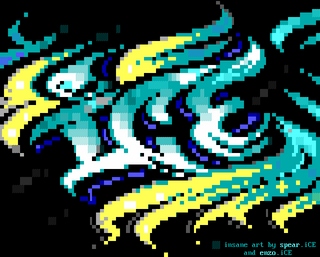
ASCII art is a graphic design technique that uses computers for presentation and consists of pictures pieced together from the 95 printable characters defined by the ASCII Standard from 1963 and ASCII compliant character sets with proprietary extended characters. The term is also loosely used to refer to text-based visual art in general. ASCII art can be created with any text editor, and is often used with free-form languages. Most examples of ASCII art require a fixed-width font such as Courier for presentation.

A bulletin board system (BBS), also called computer bulletin board service (CBBS), is a computer server running software that allows users to connect to the system using a terminal program. Once logged in, the user can perform functions such as uploading and downloading software and data, reading news and bulletins, and exchanging messages with other users through public message boards and sometimes via direct chatting. In the early 1980s, message networks such as FidoNet were developed to provide services such as NetMail, which is similar to internet-based email.
The computer art scene, or simply artscene, is the community interested and active in the creation of computer-based artwork.
In a bulletin board system (BBS), a door is an interface between the BBS software and an external application. The term is also used to refer to the external application, a computer program that runs outside of the main bulletin board program. Sometimes called external programs, doors are the most common way to add games, utilities, and other extensions to BBSes. Because BBSes typically depended on the telephone system, BBSes and door programs tended to be local in nature, unlike modern Internet games and applications.
ACiD Productions (ACiD) is a digital art group. Founded in 1990, the group originally specialized in ANSI artwork for BBSes. More recently, they have extended their reach into other graphical media and computer software development. During the BBS-era, their biggest competitor was iCE Advertisements.

The Kosmic Free Music Foundation was a worldwide group of computer musicians, artists, and coders focused on the PC demoscene. Most members were from the United States, Canada, and Australia. They created music - mostly techno, trance, and ambient - with tracker software. They also created some artwork and demos. All their productions were freely available to download from BBSes and the internet. In the 1990s, they were known for having many of the tracking scene's top musicians as members. Their early presence on the Internet made them one of the first netlabels. The leader of Kosmic was Dan Nicholson, who went by the alias Maelcum.
Christian Wirth, better known by the pseudonym RaD Man, is an American computer artist and historian. He works in the field of ANSI art, a method of creating art using a limited set of text characters and color escape codes based loosely on the relevant ANSI standard.
ANSI art is a computer art form that was widely used at one time on bulletin board systems. It is similar to ASCII art, but constructed from a larger set of 256 letters, numbers, and symbols — all codes found in IBM code page 437, often referred to as extended ASCII and used in MS-DOS and Unix environments. ANSI art also contains special ANSI escape sequences that color text with the 16 foreground and 8 background colours offered by ANSI.SYS, an MS-DOS device driver loosely based upon the ANSI X3.64 standard for text terminals. Some ANSI artists take advantage of the cursor control sequences within ANSI X3.64 in order to create animations, commonly referred to as ANSImations. ANSI art and text files which incorporate ANSI codes carry the de facto.ANS file extension.
An artpack is an archive of computer artwork which is distributed in a compressed format such as ZIP or RAR.

iCE Advertisements is a digital art group founded in Canada by Many Axe in 1991. Although the expanded title is rarely ever used, iCE is an acronym for Insane Creators Enterprise. iCE, along with ACiD Productions, was one of the most prominent and critically successful groups on the underground computer artscene.

Jason Scott Sadofsky, more commonly known as Jason Scott, is an American archivist, historian of technology, filmmaker, performer, and actor. Scott has been known by the online pseudonyms Sketch, SketchCow, The Slipped Disk, and textfiles. He has been called "the figurehead of the digital archiving world".
The Humble Guys (THG) were a cracking group for the IBM PC during the late 1980s founded by two friends known by the pseudonyms Candyman and Fabulous Furlough. The group was also noticed in the demoscene for some of their cracktros.

FirstClass is a client–server groupware, email, online conferencing, voice and fax services, and bulletin-board system for Windows, macOS, and Linux. FirstClass's primary markets are the higher-education and K-12 education sectors, including four of the top ten largest school districts in the United States.
WWIVnet was a Bulletin board system (BBS) network for WWIV-based BBSes. It was created by Wayne Bell on December 1, 1987. The system was similar to FidoNet in purpose, but used a very different routing mechanism that was more automated and distributed.
A text game or text-based game is an electronic game that uses a text-based user interface, that is, the user interface employs a set of encodable characters, such as ASCII, instead of bitmap or vector graphics.
Celerity BBS was a descendant of the freely distributed source of TCS BBS 1.43, and ultimately nearly completely rewritten.

Phantom Access was the name given to a series of hacking programs written by Patrick Kroupa of LOD. The programs were worked on during the early to mid 80s (1982–1986), and designed to run on the Apple II computer and Apple-Cat modem.
The term ASCII porn –sometimes typographically euphemized as "ASCII pr0n"– describes pornographic images consisting of ASCII art. ASCII porn was the world's first Internet pornography, and was popular before the invention of the World-Wide Web, and often found on BBSes and other text mode terminal-based systems that could be reached via direct modem dial-up. It was also exchanged via sneakernet and on the early Internet using pre-WWW services such as email, telnet, and usenet.
Blue Board is a bulletin board system software created by Martin Sikes (1968–2007) for the Commodore 64 in the 1980s in Vancouver, British Columbia, Canada, and sold worldwide. Due to optimized code and memory allocation, Blue Board boasted very fast performance for a BBS on that hardware platform. In fact, Blue Board was faster than most if not all BBSs run on 8-bit computers. This speed combined with its use of the ASCII character set and XModem file transfer protocol rather than PETSCII and the Commodore-specific Punter protocol sometimes led users to believe that they were calling a BBS running on a much larger and faster computer.
Aces of ANSI Art was the first group of artists specifically organized for the purposes of creating and distributing ANSI art. The group was founded and operated by two BBS enthusiasts from California, "Zyphril" and "Chips Ahoy", from 1989 through 1991.







